- Home
- Compare Systems
- Cheap Systems
- Free Quotes
- DIY Systems
- Hardwired Systems
- Wireless Systems
- Smoke Detectors
- Medical Alarms
- Alarm Monitoring
- Cameras & Video
- Ademco
- ADT Security
- Brinks Security
- Broadview
- DSC Security
- FBI Alarms
- GE Security
- Honeywell
- Link Interactive
- Monitronics
- Moose
- Napco
- Protection 1
- Radionics
- Simplisafe
- Alarm Manuals
- Alarm System Parts
- Alarm Tools
- Troubleshooting
- FAQ
- Glossary
- Sitemap
- About Me
- Contact Me
Wire Stripper Tools, Cutters, and Crimpers
For Alarm Installation
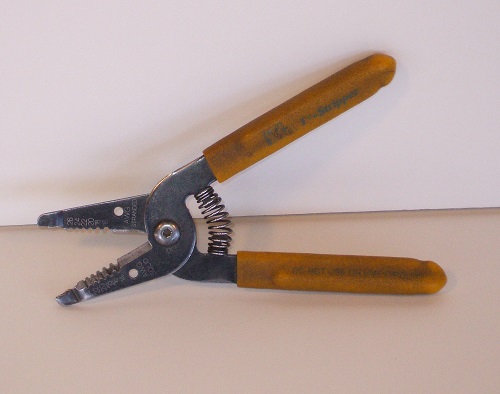
Wire stripper tools, along with cutters and crimpers, are used quite often in alarm installation and other low-voltage wiring work.
Wire Stripper Tools
Wire strippers are used to remove the outer jacket from multi-conductor cables, as well as to remove the insulation from individual wires. The blades of simple wire strippers are ground with various-sized grooves for stripping wires. Many also have flat-blade sections that double as wire cutters, and short, serrated tips that act as very fine gripping “pliers” tips.
Automatic wire strippers don’t use specifically sized grooves to strip wires; instead, they use finely-grooved or serrated jaws to grip the jacketing or insulation, and rely on leverage from the handles to generate enough tension to remove the jacket or insulation.
I’ve used some of these that work well, but none that seemed to work consistently on all kinds of wire. Also, automatic strippers don't usually work at all on multi-conductor cables. This means I need to have a simple wire stripper tool for removing cable jacket anyway.
In the end, I’ve found it easier and more natural to use a standard-type wire stripper and adjust my technique to suit the wire at hand.
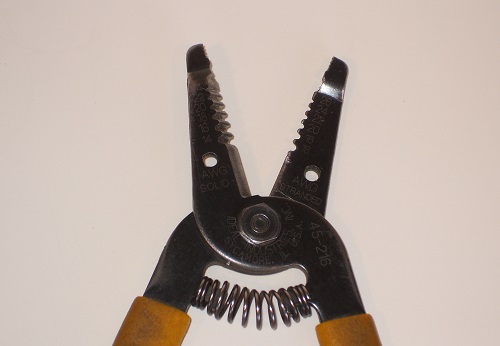
Wire stripper suppliers design tools with a range of wire gauges
that can be stripped. I’ve used various models of the Ideal brand
“T-Stripper” cable stripping tool for years. The Ideal wire stripper was
inexpensive, and was capable of cutting, stripping, and bending most
low-voltage wiring.
For alarm work, a non-automatic, general wire stripper tool that can handle gauges from 18 AWG to 26 AWG is the most useful.
The
grooves for 18 AWG and 16 AWG wires work very well for scoring the
outer jacketing of most 22/4 and 22/2 cables, respectively. The 22 AWG
grooves can then be used to remove the insulation from the individual
wires.
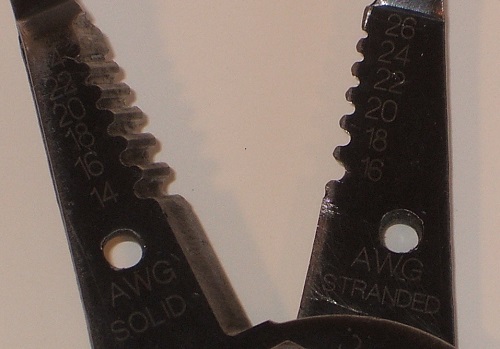
I recommend getting a wire stripper tool that includes 24 and/or
26 AWG size because copper telephone wiring is so often involved in
alarm work, and it’s handy to be able to strip the conductors bare for
testing, splicing, or making connections to screw terminals.
Some other wire stripper tool features that aren’t absolutely necessary, but are handy to have, include:
- Spring-loaded handles that open automatically
- Wire looping holes, to form a bend when connecting to screw terminals
- Padded and/or textured grips, which make the tool easier and more comfortable to use
As simple as these tools are, good technique plays a big part. You don’t have to squeeze the handles with full force to cut through wire insulation or cable jacketing material. Too much force will sometimes nick the copper conductor, causing it to fail and break off when making the final connection.
Most often, a lighter touch, along with slightly rotating the handles around the wire, will be enough to score the insulation. This will allow a gentle pull with the fingers or the pliers tip to remove the cut-off material.
Wire Cutters
As mentioned above, most wire strippers also include a wire cutter function. However, wire stripper cutter blades tend to be thin, like knife blades, and are only designed to cut soft copper wire.
If you work with steel fish tapes or other heavy-gauge metal parts, I recommend saving your wire stripper and cutter blades. Instead, add a pair of linesman’s pliers and/or diagonal cutters to your tool kit for heavy-duty wire cutting chores.
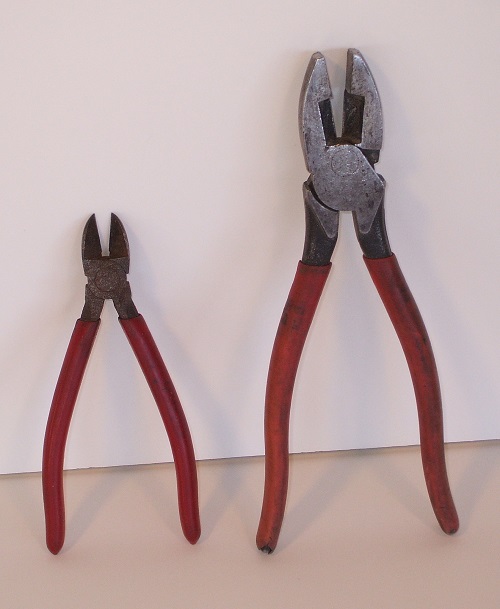
Also note
that some RG-6 and other coaxial cables have a center conductor made of
copper-clad steel. Most wire stripper tools with cutting blades will cut this type of RG-6, but the steel will dull the blades
quickly. If you can, use diagonal cutters instead of your wire stripping
tool to cut these cables.
Terminal Crimping Tool
A terminal crimping tool is not only good for securing ring, spade, and other terminals to wires. It is also great for crimping (and uncrimping) the “B” or “beanie” connectors used almost everywhere in alarm installation.
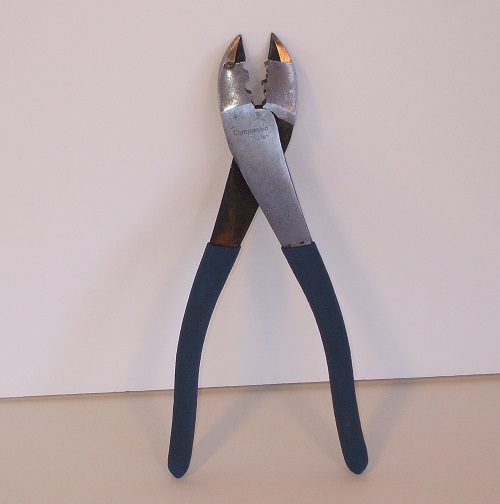
As a bonus, most crimping tool manufacturers also include a narrow nipper-type cutting section at the nose of their crimping tools. If the nipper is made well, it also happens to be perfect for cutting off the tag ends when installing nylon tie straps.
The nipper is also
good for cutting a cable tie off of a bundle of wires without damaging
the wire conductors or jacketing. If your crimping tool cuts tie straps
cleanly, hang on to it. Not all crimper/cutters will do this job very
well.
The jaws of most wire crimping tools are usually machined
with several different profiles, so they can crimp a terminal in various
ways.
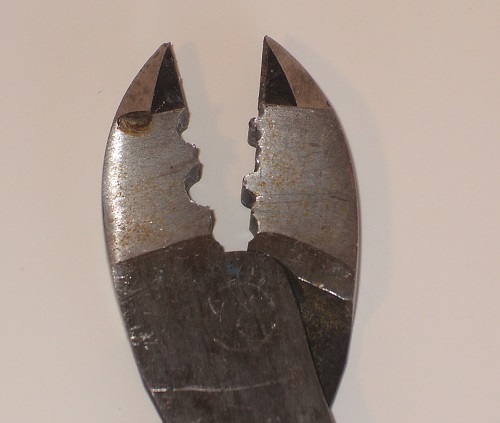
As an alarm installation and service tool, I’ve found the most useful notches to be the shallow ridged area, in the middle of the jaws, and the “U”-shaped notches.
The shallow ridged profile is best for crimping and uncrimping standard B-connectors, because it doesn't put a deep groove in the connector. By avoiding the deep groove, the connector can be uncrimped pretty easily.
The U-notches with opposing teeth is best for actual crimp terminals and for the cap-style crimps. These fittings are made of heavier-gauge metal than the softer B-connectors, and need the extra “bite” of the U-shape to grip the wires securely.
Related Articles:
The Digital Multimeter as an Alarm Installation Tool
Using a Tone and Probe Kit for Finding Cut Alarm Wires
Using a Continuity Tester for Alarm Installation and Service
MagLite LED Flashlight and Other Small Flashlights
Electrician Tool Pouch And Other Tool Bags and Buckets
Return to Alarm Installation Tools from Wire Strippers, Cutters, and Crimpers
Return to Home-Security-Systems-Answers from Wire Strippers, Cutters, and Crimpers
Note: Feel free to print any of the articles on this site for personal, non-commercial use. Just look for this button:
If you found this website especially helpful, you might want to consider making a small donation. Since 2011, AzAlarmGuy has been providing free help and advice on home security systems to all of those in need.
Your gift, in any amount, will help me keep this website a free resource for anyone needing help with alarm system issues or questions.
Disclosure
I receive affiliate commissions from some of the companies and products I discuss. These commissions don't change the price that you pay.
Rest assured that this compensation does not influence my recommendations. I only endorse products and services that I truly believe to be an honest value for you, as a visitor to my site.
For more details, see my full disclaimer.





